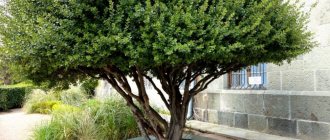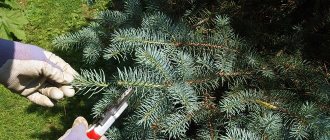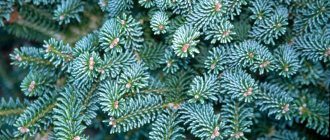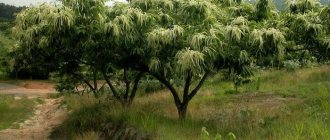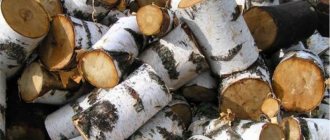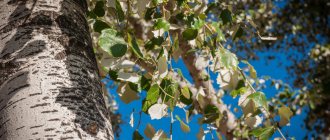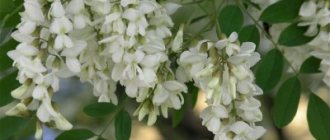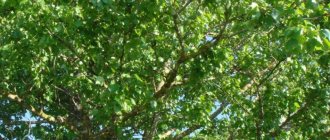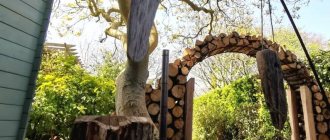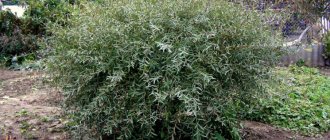For landscaping garden plots, different types of plantings are often used. Siberian fir is one of the common types of tall trees that grows faster than other species, but lives less than them. In addition to its decorative value, the crop has a high value, so by planting it on your site, you can get two in one.
Siberian fir - description
The Latin name of the species is Abies sibirica. The habitat does not extend beyond Russia. In the wild, trees form fir forests or mix with Siberian pine. The characteristics of Siberian fir are as follows:
- During the first 10 years of its life, the tree grows very slowly; after this time, the process accelerates.
- Fir is a shade-tolerant species and grows well in a variety of forests, but it is important to remember that the tree itself provides such deep shade that only a few shade-tolerant grasses and moss can grow normally under its crown.
- The root system of Siberian fir depends on the soil in which it grows. In dry soil there will be a main tap root, which increases the wind resistance of the crop, and with abundant additional watering, the root system grows superficially, which is a problem for this plant.
- Siberian fir does not tolerate high gas and smoke levels in the air.
- The needles are used to prepare natural fir balsam, because they contain 4% essential oils.
- A tree lives on average 350 years.
What does Siberian fir look like?
This type of crop is often used in gardening and landscaping of various areas. Fir is used for single or group plantings, creating alleys and high hedges. Many people are interested in how Siberian fir blooms. The first thing you need to know is that this can only happen when the tree reaches 60 years of age. This happens in May, when yellowish spikelets with male generative organs appear against the background of green needles. The external characteristics of Siberian fir are as follows:
- average height up to 60 m;
- trunk diameter is about 2 m;
- the crown is relatively small, cone-shaped, up to 2 m in diameter;
- the branches are thin;
- the needles are smooth, flat and grow up to 3 cm in length;
- needle life expectancy is up to 10 years;
- the bark is not as thick as others, light gray in color;
- Siberian fir has cones, colored red-violet or green, growing vertically.
Features of planting and growing a tree
In order for fir to delight you with its healthy appearance for decades, you should plant the tree correctly and provide it with proper care. First, they begin preparatory activities. This means choosing the place and time of planting, preparing the soil and seedlings.
First of all, it is necessary to identify the characteristics of growing a crop. It is quite frost-resistant - it can withstand temperatures down to –50°C, but does not feel well at +35°C and above. Does not tolerate strong air pollution and dry air.
Fir grows best in a well-lit place
Landing place
Fir should be planted away from busy highways and industrial facilities. Therefore, country estates would be an ideal place. The site is selected depending on the structure of the soil and the purpose of the planted fir trees. The first refers to the difference in the formation of the root system. Thus, in loose soil, the roots lie close to the surface, which makes the tree unstable to winds. And in dry soil the root is tap-shaped, which increases wind resistance. In the first case, it is recommended to select a place for the fir without drafts. Fir grows better in shade, but easily adapts to sunny areas.
Depending on what composition is planned to be obtained, a scheme for planting seedlings is drawn up. This also influences the choice of tree location. Here are some possible landing options:
- alley - trees are placed at a distance of 4–5 m from each other;
- checkerboard order - trees are planted in the shape of a square at a distance of 3 m;
- group plantings - maintain a distance of 3 m between conifers;
- single plantings - any other crops can be planted nearby.
The soil
Fir successfully takes root in fertile and poor soils. But it reaches its maximum decorative effect in soil with the following characteristics:
- moderately humid;
- loams;
- with large inclusions of limestone;
- enriched with humus.
Time
The time for planting fir is determined depending on a number of factors. If the seedlings have a closed root system (in a container), then planting from spring to autumn is permissible. Material aged from 5 to 10 years is recommended to be planted in early spring (in April - when the snow cover is melting) or in autumn (in September - while the ground is still warm). A cloudy day, preferably after rain, is suitable for planting a tree.
Selection of seedlings
It is better to buy seedlings in a container and transplant them into open ground using the transshipment method
Now you can buy Siberian fir seedlings without any problems, but it is preferable to contact professional nurseries or specialized stores for them. When purchasing, you should pay attention to the external condition of the seedlings. The presence of any mechanical damage and signs of disease is unacceptable. If you purchase planting material in a container, the soil should be moist and free of debris.
Siberian fir - varieties
Currently, you can find the following varieties of decorative forms of culture, which differ in the color of their needles:
- Elegance
– silver; - Alba
– white; - Glauca
– blue; - Variegata
– variegated; - Viridis
– bright green.
The most popular varieties: Bajkal, Jörg, Gorno Altaisk, Kolac Hexe, Liptovsky Hradec, Łukasz, Nordlicht, Sasha, Telezsko Osero. Siberian fir is an evergreen plant, which, thanks to the work of breeders, has varieties with different types of crown:
- pyramidal in Pyramidalis;
- weeping in Pendula;
- shrubby at Nana.
Application in the treatment of diseases
Siberian fir has many positive properties. It includes substances that have a beneficial effect on health, biologically important components and vitamins. Needles are considered a source of ascorbic acid, which has an antioxidant effect. Vitamins contained in plant materials help break down toxins and remove them from the body.
Phytoncides effectively fight viral agents, accelerate the healing of injured skin surfaces and regulate the production of digestive enzymes. Also, the presence of pine needles in a room can disinfect the air, eliminate bronchospasms and alleviate most diseases of the upper respiratory tract. Due to its expectorant effect, fir can be used to clear the airways during a wet cough.
Fir cones are used to treat rheumatism and other joint diseases. Most often they resort to using a steam bath for their feet. For this purpose, pour boiling water over the pine cones and hold the feet above the steam, while covering them with a thick cloth.
Fir branches contain many essential oils, which is why they are used to produce fir oil. Decoctions and infusions are used in the fight against diseases of the respiratory system. Fir extract has antiulcer and hepatoprotective effects.
Siberian fir - planting
The optimal time for such work is April or September. It is better to plant by transshipment. When planting several plants, it is important to maintain the distance between them:
- alley planting indentation of about 5 m;
- in a group – 3.5 m;
- with a checkerboard pattern - 3 m.
The work order is as follows:
- Dig a hole 70 cm deep, 55 cm wide and long. This must be done 2 weeks before the expected planting date.
- Drainage is poured onto the bottom, the layer thickness is 20 cm.
- Pour any mineral fertilizer and add 250 g of lime.
- The Siberian fir seedling is placed in such a way that the root collar remains above the ground.
- The hole is filled in and the soil is compacted.
- Water generously.
Soil for Siberian fir
All trees of this species need nutritious and well-moistened soil. The tree prefers loamy soil, which contains humus in high quantities. The soil should be moist and have good air permeability. Only in this way will all the efforts spent on planting Siberian fir and caring for it have a positive result in the form of a beautiful tree.
Choosing a landing site
A site with suitable conditions for the crop is the key to successful fir growing. The plant feels good next to a reservoir, but the soil should not be over-moistened or constantly swamped. This perennial has a powerful root system that goes deep, so close passage of groundwater will lead to rot and death of the tree. You can plant a seedling in an orchard, on an alpine hill (ornamental varieties), or take it to the dacha. The main thing is to choose the right place so that you don’t have to replant.
Fir characteristics:
- shade-tolerant;
- winter-hardy;
- moisture-loving;
- a young tree requires protection from strong winds and drafts;
- does not tolerate gas pollution and smoke in large cities;
- prefers drained, fertile soils.
On a note! Spring sun and dry air lead to damage to the shoots, but when favorable conditions are created, the damaged crown is restored.
Lighting for fir
The breed grows in the wild in shady forests, so it thrives in partial shade and shade. When planting a single plant, it should be taken into account that direct sunlight can cause needles to burn. At the same time, an open area where there is the possibility of slight shading of young seedlings will allow the fir to develop well, promote rapid growth, and accelerate seed bearing. In the forest, seed material is formed after 60-70 years, with single plantings after 30 years.
The breed grows in the wild in shady forests, so it thrives in partial shade and shade.
Is fir demanding on soil?
The culture needs loose, nutritious, slightly acidic soil that allows air and moisture to pass through well. The soil must have a sufficient amount of essential nutrients, so it must be fertilized before planting. Heavy clay soil and close groundwater flow require a drainage layer. When growing on sandstone, it is recommended to coat the bottom of the pit with clay.
Siberian fir - care
The plant does not require any unique recommendations. The Siberian fir tree needs the following care:
- Watering
. Additional moisture is required several times a season in dry weather. The rest of the time, fir has enough natural precipitation. - Feeding
. The first application of fertilizers is 3 years after planting. The procedure is carried out in the spring, 115 g of the Kemira-universal composition is added to the tree trunk. - Soil care
. Siberian fir needs regular weed removal and surface loosening of the soil. Additionally, it is recommended to mulch with sawdust or pieces of bark. - Trimming
. The decorative look does not require such actions to form the crown. The only thing you need to do is remove dried and diseased branches.
Pruning Siberian fir
The tree, depending on the variety, has a certain shape, but sometimes additional crown formation may be required. Similar work is carried out until sap flow begins. Siberian fir in a summer cottage is trimmed with garden shears with sharp edges. Initially, all dry and deformed branches are removed and only then proceed to molding pruning. No more than 1/3 of the length can be removed at a time, otherwise the tree will stop growing and lose its attractiveness.
Siberian fir - diseases and pests
With the correct planting location and compliance with the rules of agricultural technology, Siberian fir in the country will have good immunity. Among insects, aphids may attack, this is evidenced by a change in the color of the needles. For removal, treatment is carried out with Antio or Rogor. Spraying is carried out in March. To prepare the solution, use 20 g of the drug and 10 liters of water. The appearance of growths indicates a fungal infection. All diseased parts are removed, and the tree is treated with a 2% solution of Bordeaux mixture.
Chemical composition
The benefits of fir in the treatment of many diseases are determined by the components in its composition. All parts of the plant contain essential oil: needles - 1.5-3.5%, wood - up to 4.2%, roots - 8%, resin (fir balsam) - 30%. Under industrial conditions, essential oil is obtained from young branches and cones, which serves for the semi-synthesis of medicinal camphor.
Fir essential oil consists of half bornyl acetate. It also contains camphene (10-20%), α-pinene (8-12%), α-phellandrene, borneol, dipentene, abolene, santhene, campherene, acetylaldehyde, etc.
Fir needles are a rich source of vitamin C - 200-900 mg%, the maximum amount of which accumulates in April. In addition, vitamin E, carotene, proteins, carbohydrates, phytoncides, flavonoids, microelements - iron, manganese, cobalt, zinc, copper, etc. were found in the needles.
Fir seeds contain vitamin E and up to 30% fatty acids, such as oleic, lauric, kairinic, etc. Up to 13% of tannins are found in the bark.
Siberian fir - reproduction
There are two ways to increase the number of trees without purchasing new ones. Propagation by cuttings of Siberian fir is carried out as follows:
- The preparation is carried out before the start of the sap flow process.
- The optimal length of the correct cutting is 6 cm.
- It is not cut, but torn off so that a little bark remains.
- The cuttings are placed in a manganese solution.
- The container is filled with a mixture of humus, leaf soil and sand.
- After planting, the containers are covered with film.
- The temperature should be above room temperature. It is important to water and ventilate.
- Cuttings take root only in the second year.
The seed method is rarely used. It includes the following steps:
- Siberian fir seeds are extracted from an unripe cone or purchased in a specialized store.
- It is mandatory to carry out stratification before sowing.
- Planting takes place in April. The seeds are immersed in the soil to a depth of 2 cm. Watered and covered with film.
- The first shoots appear a month later. It is important to water, remove weeds and loosen the soil.
How to propagate fir
There are 3 main methods - sowing seeds, cuttings and using layering. This coniferous perennial is characterized by monoecy - female and male cones ripen on the same tree. You can grow fir only from the first ones. Suitable seeds are distinguished by the presence of a small wing. The difficulty of such propagation lies in the fact that only seed material from adult plants can be used for planting, and their cones are located very high. At the same time, the seeds crack and spill out while still on the branch.
Suitable seeds are distinguished by the presence of a small wing.
If you manage to find an unripe cone, it should be left to dry at room temperature. When the seeds fall out, begin stratification - keep them moist in the refrigerator for about 2-3 months. It is recommended to sow in mid-April directly into open ground or a separate container with good drainage. Do not pick to avoid damaging the delicate root system.
To propagate fir by cuttings, from the upper part of the crown of a tree 4-8 years old, pick a branch 5-8 cm long with an apical bud and heel. This can be done in April, June, August, September or October. Plant green cuttings immediately, and store lignified ones until spring at a temperature of 1-5°C and high humidity. Before the procedure, treat with fungicides, then plant, creating greenhouse conditions using glass or film. When propagated from a twig, only 1/2-2/3 survives, so you need to use several cuttings.
To propagate fir by cuttings, from the upper part of the crown of a tree 4-8 years old, pick a branch 5-8 cm long with an apical bud and heel.
Layers are produced when the lower shoots of the mother tree touch the ground and produce roots. This process takes 1-2 years. If desired, the gardener can grow cuttings himself. The disadvantage of this method is that the shape of the new fir can be very different from the mother fir. It is used when you want to grow an unusual plant or bonsai tree.
Siberian fir in landscape design
Thanks to its external beauty, the tree will look beautiful as a single plant or in a composition with a variety of trees and shrubs. Let's consider several interesting options:
- Siberian fir planted near the building;
- decorative variety in a flowerbed in the company of various plants;
- fir trees with blue spruce and bright flowers;
- several tall trees in a group planting;
- Siberian fir hedge;
- a plant on the edge of the plot surrounded by different trees and flowers;
- small fir among the stones.
Medicinal properties
Traditional medicine uses young shoots, needles, buds and bark of the Siberian species. At the beginning of spring, buds are harvested, and at the end - twigs. Needles can be collected in the summer or from October to February. Scientific research has shown the feasibility of internal and external use of plant-based products.
Traditional medicine uses young shoots, needles, buds and bark of the Siberian species.
Healing properties of Siberian fir:
- has tonic, expectorant, analgesic, antiviral, antibacterial effects;
- heals wounds, restores necrotic tissue;
- used as a prophylactic against oncology and cardiovascular pathological conditions;
- helps relieve symptoms and recover faster from ARVI, flu, sore throat, sinusitis;
- restores strength after a long illness and surgery;
- relieves eye tension;
- helps fight insomnia and central nervous system disorders.
On a note! Camphor stimulates breathing and blood circulation, stimulates the central nervous system, tones the heart, and accelerates metabolism. Exceeding the permissible dosage leads to seizures.
Siberian fir is used to prepare decoctions, balsam, and oil.
Decoctions, infusions, balsam, and oil are prepared from plant material of Siberian fir. The drugs are used for rheumatism, inflammation, collapse, and chronic heart failure. Fir oil activates the sex glands and the hormonal system. Used for osteochondrosis, psoriasis, angina pectoris.
Products based on Siberian fir may have side effects.
Despite the benefits, products based on Siberian fir may have side effects. You should not consume them in large quantities or exceed the recommended dosage and duration of use. Contraindications – tendency to seizures, alcohol intoxication, allergies, individual intolerance, early childhood, ulcers of any part of the gastrointestinal tract. It is prohibited to combine treatment with fir-based products with alcohol. You should abstain from such drinks for at least 2 days after completing the course.
Siberian fir in a pot
A plant grown in a container looks impressive, but such maintenance requires compliance with certain rules:
- To make it easier to move a heavy pot, it is recommended to purchase a special stand on wheels.
- The size of Siberian fir requires the use of a 10 liter pot.
- It is important to choose a pot with good drainage. For this purpose, natural materials are used, for example, broken brick.
- It is important to leave the purchased seedling for some time to develop new conditions.
- Transplantation is carried out every 3 years. It is necessary to remove it from the pot only with a lump of earth, so as not to accidentally damage the thin roots and harm the tree.
Korean fir (Abies koreana)
It grows naturally in the mountainous regions of the southern part of the Korean Peninsula. Tree up to 10–12 m tall. The needles are hard, shiny, 1.5–2 cm long. The cones are cylindrical, 5–7 cm long, in some species and forms they are purple-violet; they are also found in brown and green colors.
Korean fir
Korean fir variety Aurea (Flava)
Tree up to 7 m high with a conical crown. The needles are yellowish-green, young ones are bright yellow. Susceptible to spring burns.
Korean fir variety Aurea (Flava)
Korean fir variety Silberlocke
A popular slow-growing variety up to 4 m high with a wide-conical crown. The needles are blue-green, silvery on the underside. The buds are purple-blue.
Korean fir variety Silberlocke
Korean fir variety Grubele
A relatively new slow-growing variety of Korean fir. The needles are short and wide.
Korean fir variety Grubele
Korean fir variety Silver Star
A dwarf fir of a wide conical shape, about 1 m high at 10 years of age. The needles are short, gray-bluish, twisted, silvery-white below. The buds are purple-blue.
Korean fir variety Silver Star
Korean fir variety Tundra
A variety up to 0.6–1 m high with a dense spherical crown. The needles are quite fluffy and dense.
Subalpine fir (Abies lasiocarpa)
Fir is native to North America. In nature, the tree is 15–30 m high, in culture – up to 8 m. The needles are up to 3 cm long and up to 2 mm wide, greenish-gray, with stomatal stripes not only on the lower, but also on the upper side. Immature buds are purple-reddish.
Subalpine fir
Subalpine fir variety Compacta (A. arizonica var. glauca compacta)
A slow-growing dwarf variety with a dense crown, up to 3 m high. Short needles are silver-blue in color.
Subalpine fir variety Argentea
One of the most beautiful varieties of mountain fir. A dense coniferous tree with a conical shape, reaching a height of 8 m.
Subalpine fir variety Argentea
